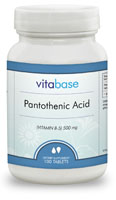| Vitamin B5 is found in a very wide variety of foods. Foods that have high levels of vitamin B5 include organ meats (e.g. liver and kidney), eggs, fish and shellfish, lobsters, poultry, soybeans, lentils, split peas, milk, yoghurt, avocado, mushrooms and sweet potatoes. The best sources of pantothenic acid include eggs, liver, fish, chicken, whole grain breads, cereals and legumes.
Other good sources are cauliflower, broccoli, lean beef, white and sweet potatoes, and tomatoes. Most fresh vegetables are good sources for Vitamin B-5. Brewer's and nutritional yeast, liver, eggs, mushrooms, avocados, broccoli, whole grains, bran, peanuts, cashews, legumes, and soybeans are especially high in vitamin B5. Pantothenic acid is found throughout living cells in the form of coenzyme A (CoA), a vital coenzyme in numerous chemical reactions. Liver, yeast, and salmon have high concentrations of pantothenic acid, but most other foods, including vegetables, dairy, eggs, grains, and meat, also provide some pantothenic acid.
Pantothenic acid is widely distributed in plant and animal food sources, where it occurs in both bound and free forms. Rich sources of the vitamin, include organ meats (liver, kidney), egg yolk, avocados, cashew nuts and peanuts, brown rice, soya, lentils, broccoli and milk. Royal jelly and brewer's yeast, both of which are used as nutritional supplements, are two of the richest sources of pantothenic acid. The richest sources of the vitamin are the ovaries of cod and tuna. Pantothenic acid is synthesized by intestinal microflora and this may also contribute to the body's pantothenic acid requirements.
Calcium pantothenate and sodium pantothenate are the principal supplemental forms of pantothenic acid most often found in nutritional supplements. This marketed supplement is usually made synthetically. Dexpanthenol, the corresponding alcohol of pantothenic acid is also available. Dexpanthenol is a synthetic form which is not found naturally. Dexpanthenol is converted to pantothenic acid in the body, and therefore can be considered a provitamin form of pantothenic acid. Dexpanthenol is used topically to promote wound healing. It is also used in various cosmetic products.
Pantothenic acid loss during processing is significant, as it is stable in neutral solution but is readily destroyed by heat in either alkali or acid. As such, significant amounts can be destroyed during food preparation. Cooking is reported to destroy 15-50% of the pantothenic acid in meat, and studies have shown that 37-78% of the vitamin in fruits and vegetables can be lost during processing. Vitamin B5 can be found in multivitamins, B complex vitamins, or sold individually under the names pantothenic acid and calcium pantothenate. It is available in a variety of forms including tablets, softgels, and capsules. |
